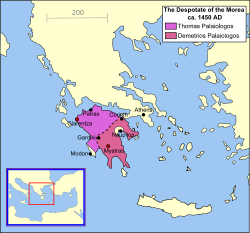Despot of Morea
| Despotate of the Morea | ||||||||||
| Δεσποτᾶτον τοῦ Μορέως | ||||||||||
| Despotate of the Byzantine Empire | ||||||||||
|
||||||||||
|
The Despotate of the Morea in 1450, divided between the two brothers, Thomas and Demetrios Palaiologos
|
||||||||||
| Capital | Mystras (with Glarentza after 1428) | |||||||||
| Languages | Medieval Greek | |||||||||
| Religion | Eastern Orthodox Church | |||||||||
| Government | Feudal monarchy | |||||||||
| Despot of Morea | ||||||||||
| • | 1349–1380 | Manuel Kantakouzenos | ||||||||
| • | 1449–1460 | Thomas Palaiologos | ||||||||
| Historical era | Late Medieval | |||||||||
| • | Established | 1349 | ||||||||
| • | Disestablished | 1460 | ||||||||
|
||||||||||
The Despotate of the Morea (Greek: Δεσποτᾶτον τοῦ Μορέως) or Despotate of Mystras (Greek: Δεσποτᾶτον τοῦ Μυστρᾶ) was a province of the Byzantine Empire which existed between the mid-14th and mid-15th centuries. Its territory varied in size during its existence but eventually grew to include almost all the southern Greek peninsula known as the Peloponnese, which was known as the Morea during the medieval and early modern periods. The territory was usually ruled by one or more sons of the current Byzantine emperor, who were given the title of despotes (in this context it should not be confused with despotism). Its capital was the fortified city of Mystras, near ancient Sparta, which became an important centre of the Palaiologan Renaissance.
The Despotate of the Morea was created out of territory seized from the Frankish Principality of Achaea. This had been organized from former Byzantine territory after the Fourth Crusade (1204). In 1259, the Principality's ruler William II Villehardouin lost the Battle of Pelagonia against the Byzantine Emperor Michael VIII Palaeologus. William was forced to ransom himself by surrendering most of the eastern part of Morea and his newly built strongholds. The surrendered territory became the nucleus of the Despotate of Morea.
A later Byzantine emperor, John VI Kantakouzenos, reorganized the territory during the mid-14th century to establish it as an appanage for his son, the Despot Manuel Kantakouzenos. The rival Palaiologos dynasty seized the Morea after Manuel's death in 1380, with Theodore I Palaiologos becoming despot in 1383. Theodore ruled until 1407, consolidating Byzantine rule and coming to terms with his more powerful neighbours—particularly the expansionist Ottoman Empire, whose suzerainty he recognised. He also sought to reinvigorate the local economy by inviting Albanians to settle in the territory.
...
Wikipedia

